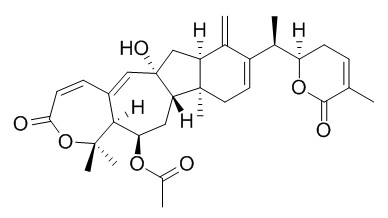Longipedlactone J
Standard reference
Inquire / Order:
manager@chemfaces.com
Technical Inquiries:
service@chemfaces.com
Tel:
+86-27-84237783
Fax:
+86-27-84254680
Address:
1 Building, No. 83, CheCheng Rd., Wuhan Economic and Technological Development Zone, Wuhan, Hubei 430056, PRC
Providing storage is as stated on the product vial and the vial is kept tightly sealed, the product can be stored for up to
24 months(2-8C).
Wherever possible, you should prepare and use solutions on the same day. However, if you need to make up stock solutions in advance, we recommend that you store the solution as aliquots in tightly sealed vials at -20C. Generally, these will be useable for up to two weeks. Before use, and prior to opening the vial we recommend that you allow your product to equilibrate to room temperature for at least 1 hour.
Need more advice on solubility, usage and handling? Please email to: service@chemfaces.com
The packaging of the product may have turned upside down during transportation, resulting in the natural compounds adhering to the neck or cap of the vial. take the vial out of its packaging and gently shake to let the compounds fall to the bottom of the vial. for liquid products, centrifuge at 200-500 RPM to gather the liquid at the bottom of the vial. try to avoid loss or contamination during handling.
Heinrich Heine University Dusseldorf2021, 62203.
Journal of Ginseng Research2024, 03.005.
Horticulture, Environment, and Biotechnology2025, 66:729-739.
Phytomedicine.2023, 117:154929.
Applied Biological Chemistry2022, 65(77).
Nutrients.2020, 12(12):3638.
J Ethnopharmacol.2017, 197:157-164
J Hematol Oncol.2018, 11(1):112
Biomed Pharmacother.2021, 144:112300.
PLoS One.2017, 12(3):e0173585
Related and Featured Products
Phytochemistry. 2008 Mar;69(5):1266-72.
Compounds from Kadsura heteroclita and related anti-HIV activity.[Pubmed:
18207206 ]
METHODS AND RESULTS:
Phytochemical investigation of the stems of Kadsura heteroclita led to isolation of 16 compounds, including the triterpenoid named Longipedlactone J (2), and two dibenzocyclooctadiene type lignans named heteroclitin I and J (3, 4). Compounds 8-10, 14, and 15 were weakly active as anti-HIV agents, whereas compounds 6 and 12 exhibited moderate anti-HIV activity with EC50 values of 1.6 microg/mL, and 1.4 microg/mL, therapeutic index (TI) values of 52.9, and 65.9, respectively. Their structures were established by spectroscopic methods, including application of 2D NMR techniques and CD spectra.



